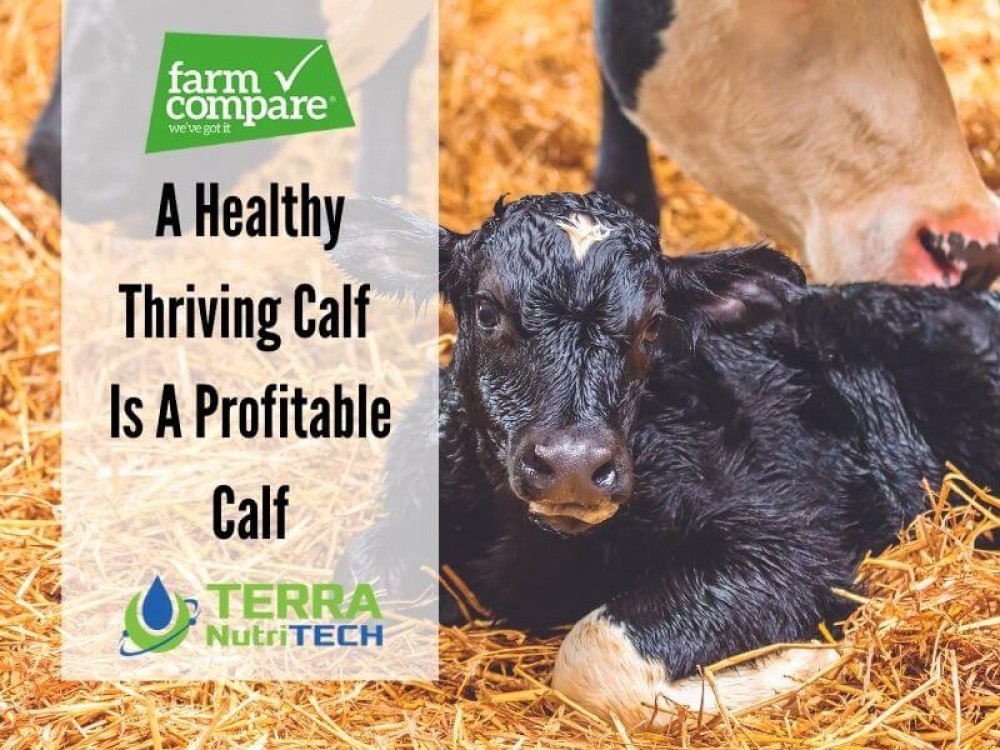A healthy thriving calf is a profitable calf

Smart calf rearing leads to healthy profits on-farm.
Farm Compare looks at the various aspects that can have a significant impact on calf health.
Environment
Calves are challenged by a series of stress factors after they are born, including changes in their surroundings, changes from the sterile uterus to natural outside conditions. Cows should calve in a clean environment and pregnant cows should be kept out of the calving area until close to calving. Temperature is also important; a study conducted by Agriculture and Horticulture Development Board (ADHD) showed that calves in warmer buildings grew better because they were not using energy to keep warm.
Immunity
Calves are born with an underdeveloped immune system and the importance of getting good quality colostrum is well known. Remember proper cow vaccination against E. coli and rotavirus and coronavirus can increase the antibodies she passes through her colostrum to the calf. It is important calves are fed 3-4 litres of colostrum as soon as possible after birth and always within six hours, as noted in a study ADHD covered.
When up against an underdeveloped immune system as farmers we want the calf to have a healthy gut allowing it to grow and reach target weights, however there are endless amounts of diseases and hazards that can prevent this such as calf scour, E.coli, Rotavirus, Bovine Virus Diarrhea or Coccidiosis.
Scouring is the most common health problem affecting young cattle and milk-fed animals is the result of altered gut function which increases the amount of manure and fluids the calf eliminates. Calves are particularly susceptible during their second week of life.
Teagasc has noted up to 40% of calf deaths in the first six weeks of life are scour-related. Feeding natural additives to newborn calves can help boost immune function and also prevent or minimise scour. Calves affected with scours are twice as likely to develop pneumonia and affect growth rates. The Agri-Food and Biosciences Institute (AFBI) highlights the importance of early detection of ill-health and why regular monitoring of growth rate throughout the rearing period is essential to maximise lifetime performance.
Ensure the calf’s nutritional needs are being met – with a diet appropriate for the calf’s growth stage, and environment. Fibre should be added to the diet in the form of hay or palatable straw. Fibre helps improve rumen health, and so will impact digestion and encourage correct nutrient absorption.
ADHD’s study noted that there is a proven link between good growth rates and first lactation yield. With the study noting to aim for heifers to calve at 22-24 months so they need to achieve a growth rate of 0.8kg/day.
.jpg)
Some of the main causes of Ill-thrift coming from; mineral deficiency – particularly cobalt, selenium, copper, and zinc, poor immune systems, and poor rumen development. With all the effort we farmers put into top quality silage it is so important to take the most from this and therefore a healthy rumen is essential as the calf will process the silage and also their concentrates.
Cow and Calf
Healthy calves are born from healthy cows so looking after your cow pre calving is essential. Metritis in cows is a metabolic disorder that is caused by the inflammation of the uterus of the animal. It is usually caused by a bacteria infection and is easy to identify. Metritis usually develops in cows in the first 5-7 days post-calving. Once a cow is identified to have metritis, it is important to seek veterinary advice immediately.
Like most metabolic disorders post-calving, metritis will have a negative effect on milk production, and if it is left untreated it can have long-term implications on the cow’s production cycle or can even result in death. Metritis can also be closely associated with retained cleanings, abortions and can be an issue at breeding time. Best practice is to minimise the risk of Metritis. A proper dry cow mineral program is a key solution to preventing Metritis in cows which really begins in the pre-calving season.
© 2026 Farm Compare Ltd. All rights reserved| T&Cs | Privacy policy | Website by Reflex Studios

This website was developed with support from Priority 6 (LEADER) of the Northern Ireland Rural Development Programme 2014-2020 by the Department of Agriculture, Environment and Rural Affairs and the European Agricultural Fund for Rural Development: Europe investing in rural areas

